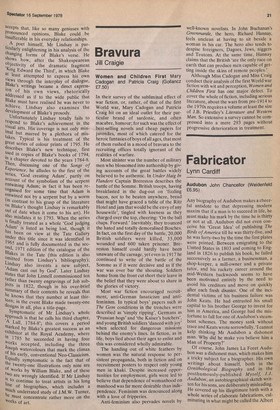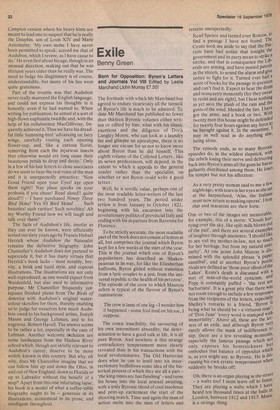Fabricator
Lynn Cardiff
Audubon John Chancellor (Weidenfeld £6.95) Any biography of Audubon makes a cheerful antidote to that depressing modern maxim that if a man is to succeed in life, he must make his mark by the time he is thirty or not at all. Audubon did not even conceive his 'Great Idea' of publishing The Birds of America till he was thirty-five, and he was forty-two by the time the first plates were printed. Between emigrating to the United States in 1803 and coming to England in 1826 to publish his book, he failed successively as a farmer, a businessman, a shop-keeper, a mill-owner and a private tutor, and his rackety career around the mid-Western backwoods seems to have been motivated entirely by the need to avoid his creditors and move on quickly after each fresh disaster. One of the incidental victims of his business failure was John Keats. He had entrusted his small capital to his brother George to invest for him in America, and George had the misfortune to fall for one of Audubon's steamboat schemes. The money sank without trace and Keats wrote sorrowfully,'! cannot kelp thinking Mr Audubon a dishonest man. Why did he make you believe him a Man of Property?' Of course, John James La Foret Audubon was a dishonest man, which makes him a tricky subject for a biographer. His own writings about himself, both in the Ornithological Biography and in the posthumously-published Myself, J.J. Audubon, an autobiographical sketch written for his sons, are deliberately misleading. He covered up his illegitimate birth with a whole series of elaborate fabrications, culminating in what might be called the Albert Campion version where his heavy hints are meant to lead one to suspect that he is really the Dauphin, son of Louis XIV and Marie Antoinette: 'My own name I have never been permitted to speak; accord me that of Audubon, which I revere, as I have cause to do.' He even lied about his age, though in an unusual direction, making out that he was thirteen years older than he really was. The need to fudge his illegitimacy is of course, understandable, but many of his lies were quite gratuitous.
Part of the trouble was that Audubon never really mastered the English language, and could not express his thoughts in it honestly, even if he had wanted to. When writing for publication, he aimed at a sort of high-flown euphuistic twaddle and, with the help of his collaborator MacGillivray, frequently achieved it. Thus we have his dreadful little humming-bird 'advancing on fairy wings, carefully visiting each opening flower-cup, and, like a curious florist, removing from each the injurious insects that otherwise would ere long cause their beauteous petals to drop and decay.' Only in a few of his late letters to close associates do we seem to hear the real voice of the man and it is unexpectedly attractive: 'Now Good Friend open your Eyes! aye open them tight!! Nay place specks on your probosis if you chuse! Read aloud!! quite aloud!!! — I have purchased Ninety Three Bird Skins? Yes 93 Bird Skins! . . Such beauties! such rarities! Such novelties! Ah my Worthy Friend how we will laugh and talk over them!'
The facts of Audubon's life, insofar as they can ever be known, were efficiently sorted out sixty years ago by Francis Hobart Herrick whose Audubon the Naturalist remains the definitive biography. John Chancellor's Audubon does not pretend to supercede it, but it has many virtues that Herrick's book lacks — most notably, brevity. a brisk and lucid style, and copious illustrations. The illustrations are not only well-reproduced, as one would expect from Weidenfeld, but also used to informative purpose. Mr Chancellor frequently juxtaposes finished plates from The Birds of America with Audubon's original watercolour sketches for them, thereby enabling us to judge for ourselves how much Audubon owed to his background artists, Joseph Mason and George Lehman, and to his engraver, Robert Havell. The answer seems to be rather a lot, especially in the case of Lehman. Another welcome inclusion are some landscapes from the Hudson River school which, though not strictly relevant to Audubon's career, deserve to be more widely known in this country. But why, oh why, does Mr Chancellor imagine that we can follow him up and down the Ohio, in and out of New England, down to Florida or up to Labrador without the benefit of a map? Apart from this one infuriating lapse, his book is a model of what a coffee-table biography ought to be — generous in its illustrations, economical in its prose, and intelligent throughout.



































 Previous page
Previous page